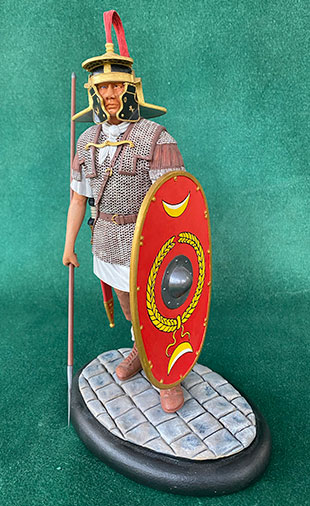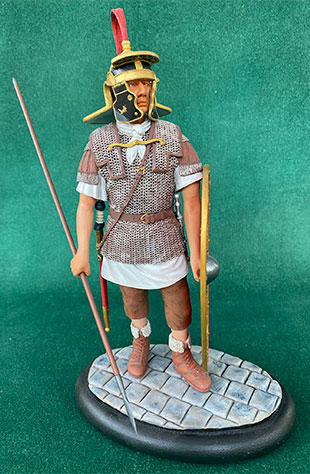

 |
|
 |
Auxiliary Cavalryman |
||

200mm Scale Resin & White Metal Kit
|
Kit No. 9003 - £55.00 Roman Cavalry Romans were never considered good horsemen, and since the role of the cavalry was not seen as important in Roman eyes, the cavalry was generally made up of non-Roman horsemen. While they would play an important part of Legionary tactics, the cavalry was considered secondary and would remain the weakest part of the Roman Army until the very late Imperial period. Generally, cavalry was used as light skirmishing troops, and mounted archers whose job was to patrol, act as scouts and messengers and to provide a mobile defensive screen while the legion was massing in battle array. As in all armies throughout history, the mounted trooper was also effective in chasing down and harassing a fleeing and panicked enemy force. The typical Auxiliary cavalry units (Ala Quingenaria) were as follows: The turma was the smallest basic unit of cavalry. Each turma consisted of 32 troopers or Eques Alaris. The turmae were under the command of a Decurion. Alae, meaning "wing" the basic ala was composed of 512 men, a total of 16 turmae. Ala Milliariae was a larger formed unit with the same structure. It was composed of up to 32 alae or roughly up to 1,000 troopers. Equites Legionis were the cavalry units attached directly to the Legion and were considered regular Legionaries of immunes rank. Originally they consisted of 120 men but may have been upwards of 1,000 men like the Ala Milliariae. Generally this unit would fall under the command of a Centurion or an Optio. The figure shown is of a Decurion, wearing chain mail with a mail cape. The shields carried were usually round or oval, although Praetorians carried hexagonal shields typically decorated with scorpions. The cavalry weapons were the spatha, a longer sword than the gladius, and a spear. Daggers were also carried and were highly decorated. The helmet could have a fore and aft crest, but is hear shown with a stand and fall plume. Helmets varied and could be highly decorated. Cavalry often wore short breeches and boots are worn as a sign of rank. ⇐ Back to models |
|
